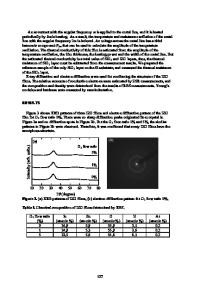Hydrogen diffusion in zinc oxide thin films
- PDF / 314,605 Bytes
- 6 Pages / 612 x 792 pts (letter) Page_size
- 47 Downloads / 458 Views
1165-M05-24
Hydrogen diffusion in zinc oxide thin films W. Beyer 1,3, U. Breuer2, F. Hamelmann3, J. Hüpkes1, A. Stärk2, H. Stiebig3, U. Zastrow1 1 IEF5-Photovoltaik, Forschungszentrum Jülich GmbH, D-52425 Jülich, Germany. 2 Zentralabteilung für Chemische Analysen, Forschungszentrum Jülich GmbH, D-52425 Jülich, Germany. 3 Malibu GmbH & Co.KG, Böttcherstrasse 7, D-33609, Bielefeld, Germany.
ABSTRACT Hydrogen diffusion in zinc oxide thin films was studied by secondary ion mass spectrometry (SIMS) measurements, investigating the spreading of implanted deuterium profiles by annealing. By effusion measurements of implanted rare gases He and Ne the microstructure of the material was characterized. While for material prepared by low pressure chemical vapour deposition an interconnected void structure and a predominant diffusion of molecular hydrogen was found, sputter-deposited ZnO films showed a more compact structure and long range diffusion of atomic hydrogen. Hydrogen diffusion energies of 1.8 – 2 eV, i.e. higher than reported in literature were found. The results are discussed in terms of a H diffusion model analogous to the model applied for hydrogen diffusion in hydrogenated amorphous and microcrystalline silicon. INTRODUCTION Thin films of zinc oxide (ZnO) are of interest as transparent conductive oxide layers for application in thin film solar cells and other devices. One ubiquitous impurity in such layers is hydrogen which has been identified as a shallow donor [1]. A strong influence of hydrogen on conductivity of single crystalline ZnO was first reported more than 50 years ago [2,3]. Various efforts were undertaken to measure H diffusion and to determine the H diffusion coefficient, both in ZnO crystals as well as in polycrystalline ZnO thin films. However, most experiments confined to the in- and out-diffusion of H [4] and not to the diffusion of H within a given sample. Here we report on a study of H diffusion using SIMS depth profiling of deuterium implantation profiles prior to and after annealing at various annealing temperatures and annealing time. We focus on polycrystalline ZnO films prepared by sputtering (SP) and by low pressure chemical vapour deposition (LPCVD). Doped as well as (nominally) undoped films were investigated. The microstructure of these films was characterized by effusion of implanted helium and neon [5]. EXPERIMENTAL DETAILS The ZnO films investigated were deposited by sputtering using ceramic target (undoped or 1 wt.% Al2O3) and by LPCVD using flows of diethylzinc and water vapor as process gases and diborane (≈ 0.2 % in gas phase) for doping. As a substrate, crystalline silicon wafers were used. For hydrogen diffusion measurements, deuterium (D+) was implanted at a dose of 1016/cm2 and at an energy of 25 and 40 keV. For microstructure analysis, He+ and Ne+ were implanted at a
Figure 1. SIMS depth profiles of ZnO, H and D for LPCVD ZnO implanted with deuterium for various annealing temperatures Ta (annealing time 10 min) (n.a.: not annealed).
Figure 2. Effusion rate dN/dt of hydr
Data Loading...










